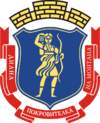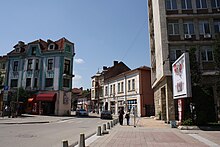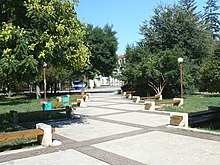Montana (Bulgaria)
| Montana (Монтана) | |||
|
|||
| Basic data | |||
|---|---|---|---|
| State : |
|
||
| Oblast : | Montana | ||
| Residents : | 39,838 (December 31, 2016) | ||
| Area : | 69.2 km² | ||
| Population density | 575.7 inhabitants / km² | ||
| Coordinates : | 43 ° 25 ' N , 23 ° 14' E | ||
| Height : | 135 m | ||
| Postal code : | 3400 | ||
| Telephone code : | (+359) 096 | ||
| License plate : | M. | ||
| administration | |||
| Mayor : | Slatko Zhivkov | ||
| Ruling party : | Bulgarian New Democracy | ||
| Website : | www.montana.bg | ||
Montana [ monˈtanɐ ] ( Bulgarian Монтана ) is a city in northwestern Bulgaria .
From 1890 the city named Ferdinand after Ferdinand of Bulgaria , who gave it city rights. Since 1944 it has been called Michailowgrad after Christo Michailow (1893–1944) and since 1993 has been called Montana again.
history
Montana was originally a Thracian settlement and later belonged to the territory of the Roman Empire . It had the Roman name Municipium Montanensium (or Montana for short).
The area around Montana was founded in 29 BC. Part of the Roman province of Moesia superior (Upper Moesia ). Around 160 AD, the military camp received city rights under the name Municipium Montanensium . The military camp was probably built on the site of an old Thracian settlement. The city was built on the Roman model and developed quickly, so that it became the second most important settlement in Upper Moesia after Ratiaria . During this time the fortress was built on the hill near Montana, as well as public buildings, temples, baths and theaters. Montana turned into a typical settlement of the Roman Empire. The Romanized local population lived here together with inhabitants of Italian and Asian Minor origins. The economic basis was formed by the large farms, the owners of which came from the heart of the Roman Empire and had villas built on their lands. On these lands the local population earned their living in agriculture. Another economic basis was gold mining on the Ogosta River (Bulgarian Огоста). The city also had a group of people with Greek roots who came from areas further east. They were mainly craftsmen and moneylenders. The goddess Diana and the god Apollo were appointed as protectors of the city .
Between 440 and 490 AD, today's northwestern Bulgaria was devastated and depopulated by the invasions of the Huns under Attila and the Goths. Between 500 and 560 AD, the Slavs and Avars dealt another devastating blow to the Greco-Roman culture of the region. The newly settled Slavs in the region called the settlement Kutlovitsa (Bulgarian Кутловица). During the First and Second Bulgarian Empire, the settlement was rebuilt and became the center of the diocese .
After the Turks took Kutlowiza, the settlement was completely destroyed and therefore abandoned by the residents. Settled by Turks because of its strategic location, the settlement flourished again between 1450 and 1688 as a typical oriental city. Two mosques were built, a bath, fountains and new buildings. That of Tschiprowtsi and its suppression with the participation of Turks from Kutlowitsa consolidate the image of Kutlowitsa as an Ottoman island and outpost against the Austro-Habsburg influence in the 18th and 19th centuries.
During the time of the liberation from Turkish rule, there were purely Turkish districts with around 600 inhabitants in the city, while otherwise 50 Bulgarians and 100 Gypsies lived in the other quarters. After the liberation there was a strong immigration to Kutlowiza. In a first wave, farmers from Belimel (Bulgarian Белимел) and Mitrowzi (Bulgarian Митровци) come. In a second big wave, residents from the area around Berkovitsa . After 1912 (Balkan Wars) resettlers came from the areas around Zaribrod (Bulgarian Цариброд), Godetschko (Годечко), Sofia , Trojan and from Macedonia . After 1944 there was a strong influx of people from all the villages in what was then the Mikhailovgrad district.
Together with the influx of the population, the city experienced its economic boom after 1878. The city was electrified, a train station was built, as well as a post office, hospital, trade fair and cultural center.
In socialist Bulgaria (after 9 September 1944) an accumulator factory, two mechanical engineering companies, a spinning mill and other companies for instrument making, floor ceramics and sanitary technology were built.
Since 2005, the city has given its name to Montana Bluff , a mountain on Livingston Island in Antarctica.
Town twinning
-
 Banská Bystrica , Slovakia
Banská Bystrica , Slovakia
-
 Schmalkalden , Germany Friendship between the German-speaking high school in Montana and the Schmalkalden high school
Schmalkalden , Germany Friendship between the German-speaking high school in Montana and the Schmalkalden high school -
 Zhytomyr , Ukraine
Zhytomyr , Ukraine
-
 Pirot , Serbia
Pirot , Serbia
-
 Dzerzhinsky , Russia
Dzerzhinsky , Russia
-
 Krynica-Zdrój , Poland
Krynica-Zdrój , Poland
-
 Agurain / Salvatierra , Spain
Agurain / Salvatierra , Spain
-
 Gudja , Malta , since 2006
Gudja , Malta , since 2006 -
 Surakarta , Indonesia
Surakarta , Indonesia
Culture and sights
- "Dragomir Asenow" theater
- historical Museum
Personalities
- Plamena Getowa (born 1953), actress
- Stilian Petrow (* 1979), football player
- Neli Rangelowa (Нели Рангелова, * 1958) singer
- Teodor Todorow (* 1989), volleyball player
Web links
Individual evidence
- ↑ ugresh.ru: “Дзержинский - О городе” (Russian, accessed June 4, 2019)





